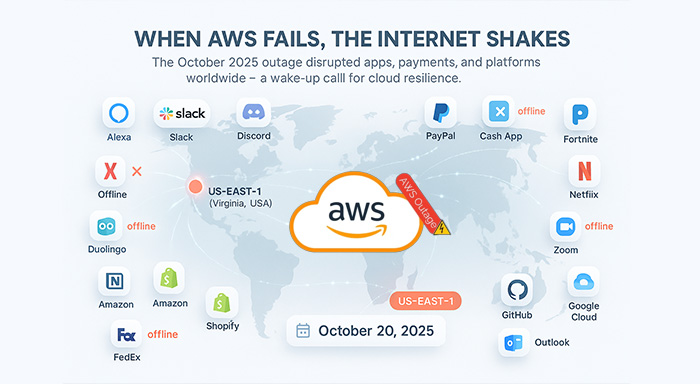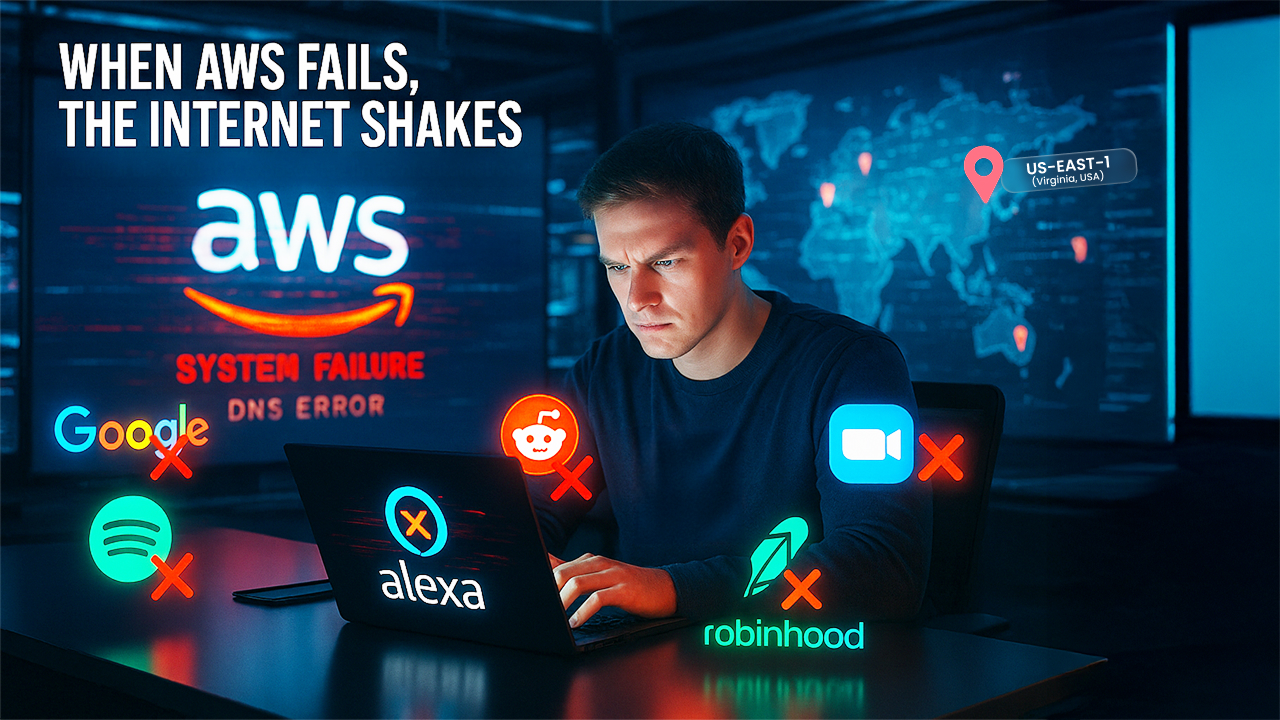In the AI-influenced digital world, many organizations think that when AI makes decisions, it will always be correct. But recent events have shown that this assumption can be unrealistic and dangerous too. On October 20, 2025, Amazon Web Services, also abbreviated as AWS, experienced a massive outage caused by a disruption in automation software. This outage not only slows down major platforms, including Google, Spotify, and Zoom, but also raises a fundamental concern about how over-reliance on AI can backfire. The idea that AI-driven and automated decisions are not always accurate now requires serious attention. Trusting too much in artificial intelligence to make informed decisions without human oversight is not just risky—it significantly erodes transparency and accountability.
What is the AWS Outage, and Why Does It Matter?

Originating from AWS’s facility in Northern Virginia, AWS recently suffered a drastic service disruption that led to errors related to the domain name system (DNS). The disruption lasted for many hours until all operations returned to normal. This outage is caused by its over-dependency on the AI-driven infrastructure management system used to track, control, and automate cloud computing operations.
Initially, the goal of AI automation in cloud services is to lower workflow costs, remove human errors, and quicken response time. But the recent incident sparked the question about whether AI tools, mainly designed as a supplement, can truly mimic human excellence. This event highlights the requirement of reevaluating the boundaries to AI automation and the vital role of human judgment in critical decision-making.
The widespread impact of this event:
- Based on several public reports, the main cause originated from a DNS configuration error disrupting the US-EAST-1 data center space.
- Due to this outage, several applications and websites face disruptions, like Reddit, T-Mobile, Verizon, and Venmo.
- Many services owned by Amazon were also affected, including Alexa, Ring, Kindle, and Prime Video.
- Also, many financial platforms like Robinhood, communication tools like Slack and Signal, and gaming channels like Roblox and Fortnite were also affected.
- It also blocks people from accessing bank services and scheduling doctor’s appointments.
So, what makes this AWS outage especially concerning is its timing. A few unreliable reports state that Amazon had scaled back a larger part of its DevOps team in favor of AI-driven automation systems immediately before the incident. While Amazon didn’t confirm any of these claims, it divides the community into two parts. Some take this alleged step as a logical move in cloud infrastructure evolution, while others warn that replacing human professionals with AI in a short timeframe may cause critical system vulnerability.
The Unseen Risks of AI Over-Dependency
People often depend on tech experts to access online services because they efficiently know the accurate point of failure. It means when one system fails, the cascading effects spread across several businesses and services. For example, AWS powers approximately 30% of cloud infrastructure globally. So, the time it goes down, it significantly impacts thousands of businesses and millions of users.
Fragility in Essential Infrastructure
The AWS disruption shows an important vulnerability at the core of advanced digital and AI automation systems as organizations rapidly switch their main workflows and machine learning pipelines to the cloud. This integration causes numerous combined challenges:
- Chain Effect: An error in a single data region can have a cascading global failure effect, highlighting that the base of the modern digital landscape could be more vulnerable than people expect.
- Hidden Reliance: In case a website or application is not hosted on AWS, there are increased chances that it depends on a customer relationship management system (CRM) or payment processors.
- Limited Options: Three essential cloud vendors manage approximately 70% of the market, so diversification alternatives remain restricted.
Significant Challenges in AI Decision-Making
The core issue in AI reliance for essential infrastructure decisions lies in the sobering reality that technology has its limitations. Tim DeStefano, an associate research professor at Georgetown's McDonough School of Business, highlights a key insight that if an outage occurs in an organization that uses AI systems to guide decision-making can directly affect performance.
AI-driven automation systems, irrespective of their advancement, work within designated parameters and training insights. They leave many human capabilities, like
- User-friendly problem-solving during unexpected situation
- Strategic awareness of larger business effect across organization
- Moral judgment in critical situations
- Responsibility for decisions created under pressure
The recent October 2025 incident was a wakeup call for businesses that showed how AI systems can lead to an exceptionally larger impact. Especially when AI systems handle critical infrastructure without human oversights, the outcome is not just technical; they can be highly disruptive. Consequently, it can exponentially increase the chances of systematic failure.
Key Lessons for the Future Cloud Providers
This recent AWS outage delivers many important lessons for organizations, technology experts, and policy builders as they transform the evolution of cloud computing and AI automation.
The Role of Balanced Automation
As companies adopt AI agents to perform critical operations and streamline the work of humans, the risk of severe disruption from an outage emerges considerably. The transition is already in progress, but the solution is not to turn away AI automation completely. Instead, the idea is to leverage AI correctly with the right protections and human oversight.
Essential Practices include:
- Managing hybrid teams where AI automate repetitive cores and human control important decisions.
- Executing powerful testing guidelines before launching AI systems in controlled environments.
- Set up a clear growing workflow when AI systems address situations outside their training metrics.
- Continuous monitoring of AI decision-making processes to recognize potential spots before they cause real harm.
The Human Intervention Remains Crucial
Everything is built on AWS. So even if the generative AI platform slows down and the cloud that runs the AI platform fails, the entire system goes down too. This additional vulnerability redefines why human excellence cannot be completely replaced by automation, especially in critical infrastructure management.
Expert professionals keep irreplaceable value through:
- Pattern identification created through years of debugging different situations
- Capability to refine solutions during unpredictable failures
- Comprehending system co-reliance that may not be addressed in AI training data
Conclusion
The AWS outage in October of 2025 acts as a strong cautionary reminder that AI is not capable of regulating critical infrastructure yet, despite its logic and representation in fiction. While cloud computing is a technological necessity for using AI, the internet backbone services will continue to combine with AI automations into the future.
As enterprises keep pursuing AI-enabled solutions to manage their infrastructure systems, they must also weigh the efficiency benefits against the risks of over dependence on automated systems. The way forward requires a careful blending of AI automation with human expertise, appropriate contingency planning, and acknowledgment of the fact that some decisions are far too important to be made entirely using AI algorithms.
The incident illustrates that while we embrace new technology, we should not lose sight of this lesson: no algorithm is smarter than human judgment when systems fail. To create a resilient and authentic future of digital infrastructure, we must acknowledge both the promise and limitations of artificial intelligence in handling the systems that the contemporary society relies on.



